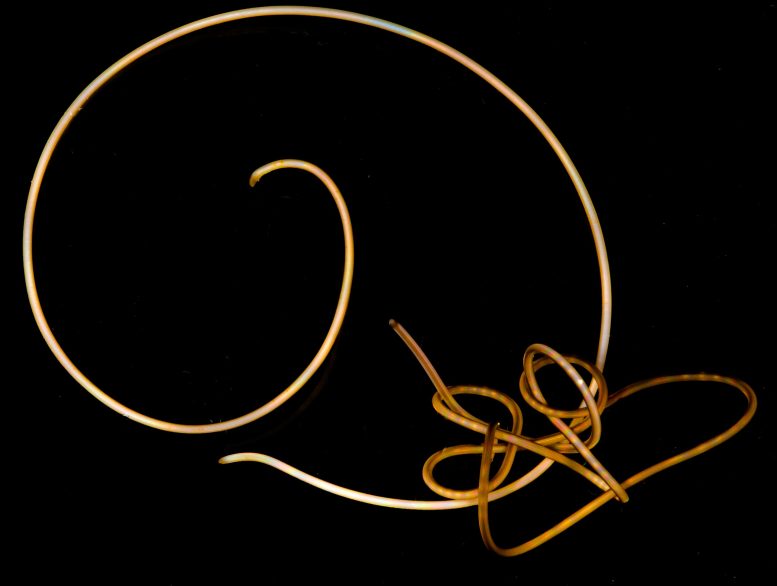
Two live tangled individuals of Gordionus violaceus, a freshwater hairworm, from Germany. Credit: Gonzalo Giribet
Hairworms are missing the tiny “hairs” responsible for cell movement, filtration, and sensing that every other known animal has.
In a world teeming with bizarre animals, hairworms arguably count among the strangest. These are parasitic worms known to manipulate the behavior of their hosts, a phenomenon sometimes termed “mind control.”
In an intriguing development, a new study in the journal Current Biology has revealed that hairworm species share a strange trait: they lack approximately 30% of the genes that researchers had anticipated finding. More intriguingly, the missing genes are linked to the development of cilia, the hair-like structures found in the cells of nearly all known animal species.
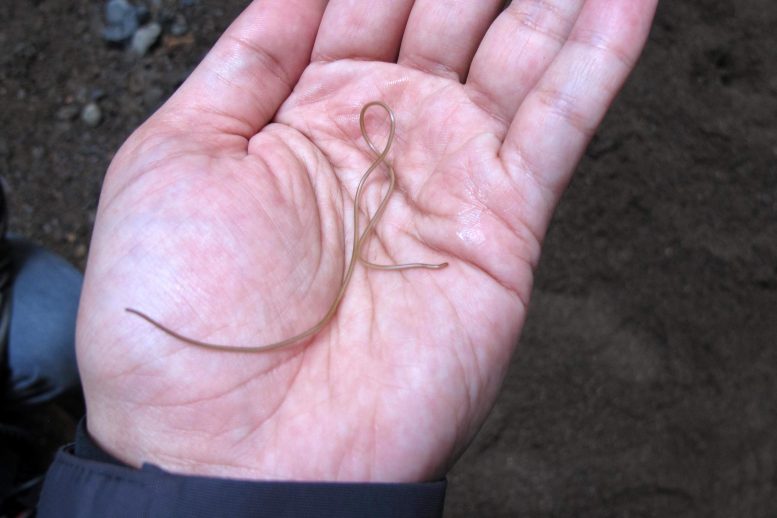
A live freshwater hairworm in Bruno de Medeiros’s hand in the Muir Woods National Monument in California. Credit: Bruno de Medeiros
Hairworms, resembling skinny strands of spaghetti and measuring a few inches long, can be found across the globe. Their basic body structure hints at their parasitic nature as they lack excretory, respiratory, or circulatory systems and live almost entirely within other creatures. Tauana Cunha, a postdoctoral researcher at Chicago’s Field Museum and lead author of the study, points out, “One of the coolest things, maybe the thing that they are most known for, is that they can affect the behavior of their hosts and make them do things that they wouldn’t do otherwise.”
Hairworm’s Life Cycle and Host Manipulation
There exist hundreds of freshwater hairworm species. The life cycle starts when their eggs hatch in water, and the larvae get consumed by small aquatic predators like mayfly larvae. These, in turn, are preyed upon by larger, terrestrial predators such as crickets. After maturing within their hosts, the hairworms manipulate the hosts’ behavior, prompting them to leap into water. Once there, the worms wriggle out from their hosts and start seeking mates, thus repeating the cycle.
While there are also five marine hairworm species that parasitize aquatic creatures like lobsters, their ability to manipulate hosts is unclear due to the absence of a need to return to the water.
Live freshwater hairworms in the environment, in the Muir Woods National Monument in California. Credit: Bruno de Medeiros
Genetic Research on Hairworms
As strange as hairworms’ behavior is, Cunha’s research interest in the animals has more to do with their DNA. “We set out to sequence their genomes, because nothing like them has ever been sequenced before at that level,” she says of the study conducted with her co-authors Bruno de Medeiros, Arianna Lord, Martin Sørensen, and Gonzalo Giribet. “The goal was to produce those genomes and eventually use them to understand the evolutionary relationships between hairworms and other kinds of animals.”
After obtaining DNA samples from two hairworm species — one freshwater and one marine — and sequencing them, the team made a startling discovery when comparing the hairworms’ genetic codes to those of other creatures.
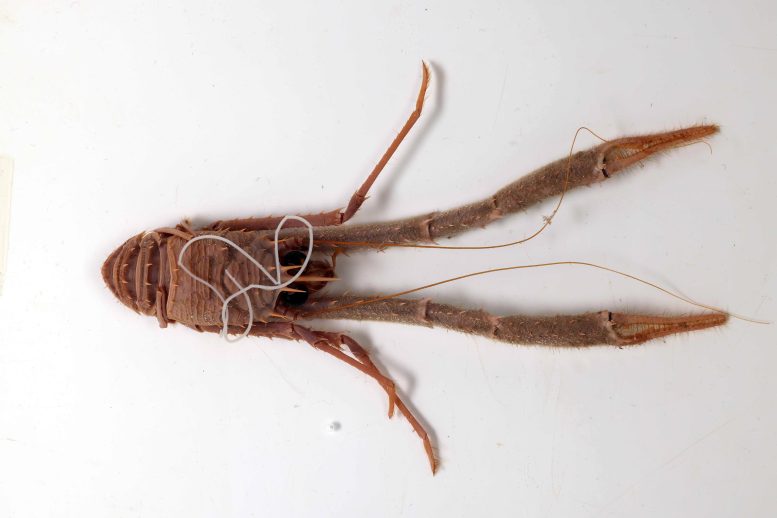
Staged photos of the (dead) squat lobster host Munida sp., from Norway, with a marine hairworm. The photo was taken now as a representation of the real scenario of how the worm was collected years ago, which was used for the genome sequencing. Credit: Martin Sørensen
Discovery of Missing Genes
“What we found, which was very surprising, was that both hairworm genomes were missing about 30% of a set of genes that are expected to be present across basically all groups of animals,” says Cunha.
Such findings typically prompt scientists to question whether they made an error. However, a correlation existed between the absent genes in both worm species. “The large majority of the missing genes were exactly the same between the two species. This was just implausible by chance,” says Cunha.
Cunha and her colleagues discovered that these missing genes in other animals are responsible for producing cilia.
“Cilia are organelles, small structures at the cellular level, that are basically present across all animals and even more broadly, in protists and some plants and fungi. So they’re present across a large diversity of life on Earth,” says Cunha. They’re present in many of the cells in the human body: for instance, the tails of sperm cells are cilia, and cells in the retinas of our eyes have cilia too.
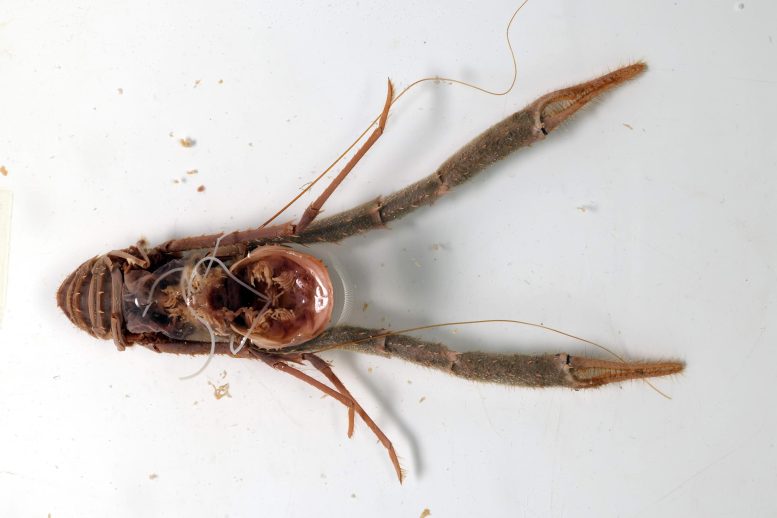
Staged photo of the (dead) squat lobster host Munida sp., from Norway, with a marine hairworm. The carapace of the lobster was opened to show the space where the worm was found. The photo was taken now as a representation of the real scenario of how the worm was collected years ago, which was used for the genome sequencing. Credit: Martin Sørensen
Implications of Missing Cilia
In earlier studies, scientists found that hairworms seemed devoid of cilia where they’d typically be observed. Hairworm sperm, for example, lack tails. However, the absence of visual evidence of cilia in hairworms was not considered as definitive proof of their non-existence. Bruno de Medeiros, Curator of Pollinating Insects at the Field Museum and co-author of the paper, states, “Without the genomes, this would require looking at all cells in all life stages in all species.”
“Based on previous observations, it didn’t seem like hairworms had any cilia, but we didn’t really know for sure,” says Cunha. “Now with the genomes, we saw that they actually lack the genes that produce cilia in other animals — they don’t have the machinery to make cilia in the first place.”
A live freshwater hairworm in Bruno de Medeiros’s hand in the Muir Woods National Monument in California. Credit: Bruno de Medeiros
Understanding Evolutionary Patterns and Future Directions
Furthermore, the fact that both freshwater and marine hairworm species have lost the genes for cilia indicates that this evolutionary change likely occurred in their common ancestor’s deep past. “It is likely that the loss happened early on in the evolution of the group, and they just have been carrying on like that,” says Cunha.
This revelation paves the way for a multitude of new queries. It’s unclear how the absence of cilia impacts hairworms or if the hairworms’ parasitic behavior is connected to the missing cilia. “There are plenty of other parasitic organisms that aren’t missing these specific genes, so we cannot say that the genes are missing because of their parasitic lifestyle,” says Cunha. “But parasitic organisms in general are often missing lots of genes. It’s hypothesized that because parasites are not using certain structures and instead rely on their hosts, they end up losing those structures.”
Implications for Future Research
Hairworms aren’t the only parasites exhibiting “mind control” traits. Similar behavior is seen in protozoans responsible for toxoplasmosis, which reduces rodents’ fear of cats, and in the fungus Ophiocordyceps, made famous by the video game and TV show The Last of Us, which manipulates ants into dispersing the fungus’s spores.
While these organisms are only distantly related to hairworms, Cunha believes that the new study could aid scientists in identifying common patterns for how this behavior functions. “By doing this comparative analysis across organisms in the future, we might be able to look for similarities. Or maybe these organisms evolved similar behaviors in completely different ways from each other,” says Cunha.
Reference: “Rampant loss of universal metazoan genes revealed by a chromosome-level genome assembly of the parasitic Nematomorpha” by Tauana J. Cunha, Bruno A.S. de Medeiros, Arianna Lord, Martin V. Sørensen and Gonzalo Giribet, 18 July 2023, Current Biology.
DOI: 10.1016/j.cub.2023.07.003

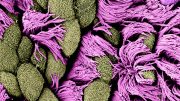
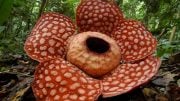
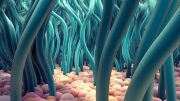
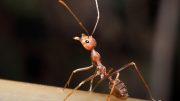
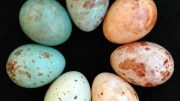
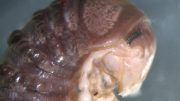

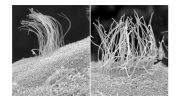
Disgusting.